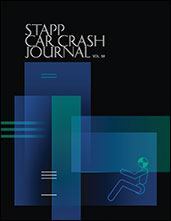2013-11-11
Development of Brain Injury Criteria (BrIC) 2013-22-0010
Rotational motion of the head as a mechanism for brain injury was proposed back in the 1940s. Since then a multitude of research studies by various institutions were conducted to confirm/reject this hypothesis. Most of the studies were conducted on animals and concluded that rotational kinematics experienced by the animal's head may cause axonal deformations large enough to induce their functional deficit. Other studies utilized physical and mathematical models of human and animal heads to derive brain injury criteria based on deformation/pressure histories computed from their models. This study differs from the previous research in the following ways: first, it uses two different detailed mathematical models of human head (SIMon and GHBMC), each validated against various human brain response datasets; then establishes physical (strain and stress based) injury criteria for various types of brain injury based on scaled animal injury data; and finally, uses Anthropomorphic Test Devices (ATDs) (Hybrid III 50th Male, Hybrid III 5th Female, THOR 50th Male, ES-2re, SID-IIs, WorldSID 50th Male, and WorldSID 5th Female) test data (NCAP, pendulum, and frontal offset tests) to establish a kinematically based brain injury criterion (BrIC) for all ATDs. Similar procedures were applied to college football data where thousands of head impacts were recorded using a six degrees of freedom (6 DOF) instrumented helmet system. Since animal injury data used in derivation of BrIC were predominantly for diffuse axonal injury (DAI) type, which is currently an AIS 4+ injury, cumulative strain damage measure (CSDM) and maximum principal strain (MPS) were used to derive risk curves for AIS 4+ anatomic brain injuries. The AIS 1+, 2+, 3+, and 5+ risk curves for CSDM and MPS were then computed using the ratios between corresponding risk curves for head injury criterion (HIC) at a 50% risk. The risk curves for BrIC were then obtained from CSDM and MPS risk curves using the linear relationship between CSDM - BrIC and MPS - BrIC respectively. AIS 3+, 4+ and 5+ field risk of anatomic brain injuries was also estimated using the National Automotive Sampling System - Crashworthiness Data System (NASS-CDS) database for crash conditions similar to the frontal NCAP and side impact conditions that the ATDs were tested in. This was done to assess the risk curve ratios derived from HIC risk curves. The results of the study indicated that: (1) the two available human head models - SIMon and GHBMC - were found to be highly correlated when CSDMs and max principal strains were compared; (2) BrIC correlates best to both - CSDM and MPS, and rotational velocity (not rotational acceleration) is the mechanism for brain injuries; and (3) the critical values for angular velocity are directionally dependent, and are independent of the ATD used for measuring them. The newly developed brain injury criterion is a complement to the existing HIC, which is based on translational accelerations. Together, the two criteria may be able to capture most brain injuries and skull fractures occurring in automotive or any other impact environment. One of the main limitations for any brain injury criterion, including BrIC, is the lack of human injury data to validate the criteria against, although some approximation for AIS 2+ injury is given based on the angular velocities calculated at 50% probability of concussion in college football players instrumented with 5 DOF helmet system. Despite the limitations, a new kinematic rotational brain injury criterion - BrIC - may offer a way to capture brain injuries in situations when using translational accelerations based HIC alone may not be sufficient.
SAE MOBILUS
Subscribers can view annotate, and download all of SAE's content. Learn More »

BOOK
Stapp Car Crash Journal Vol. 58 CD, 2014
JOURNAL ARTICLE
Assessment of the Simulated Injury Monitor (SIMon) in Analyzing Head Injuries in Pedestrian Crashes
2012-01-0569
TECHNICAL PAPER
Head Injury Potential Assessment in Frontal Impacts by Mathematical Modeling
942212
